A. D. Livingston claims to have hopscotched through life. Navy at seventeen. Mechanical engineering at Auburn. Atomic bombs at Oak Ridge. Creative writing at University of Alabama. Missiles and rockets at Huntsville. Published a novel and played a little poker. Travel editor at Southern Living magazine. Freelance writing and outdoor photography. Word man for fishing rods and bait-casting reels with Lew Childre, the genius of modern fishing tackle. Bought the family farm. Lost the back forty publishing Bass Fishing News. Lost the rest of the farm manufacturing fishing lures. Back to freelancing. Published twenty-something books. For the past sixteen yearsthe sweetest of all, he claimshe has been the food columnist for Grays Sporting Journal. What in his previous work experience qualifies him for this position? Nothing whatsoever. He hates to work, but all his life he has loved to hunt and fish and to cook and eat the bounty. And he loves to write about it his way.


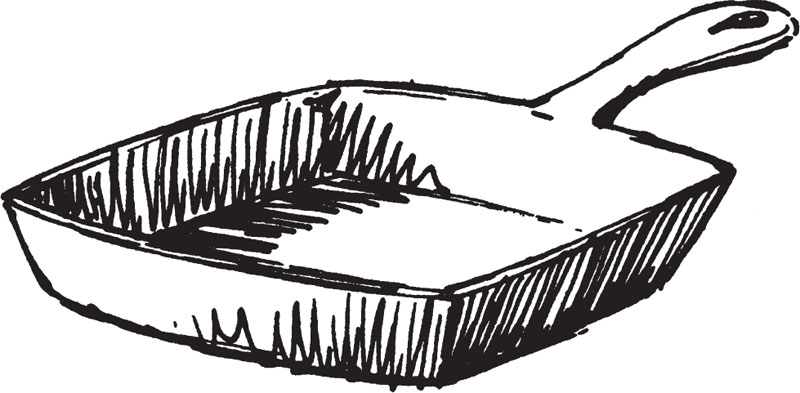

An imprint of The Rowman & Littlefield Publishing Group, Inc.
4501 Forbes Blvd., Ste. 200
Lanham, MD 20706
www.rowman.com
Distributed by NATIONAL BOOK NETWORK
Content from Cast-Iron Cooking copyright 1991, 2011 by A. D. Livingston
Content from The Curmudgeons Book of Skillet Cooking copyright 2006, 2011 by A. D. Livingston
All rights reserved . No part of this book may be reproduced in any form or by any electronic or mechanical means, including information storage and retrieval systems, without written permission from the publisher, except by a reviewer who may quote passages in a review.
A few of the recipes used in this book were adapted from the authors cooking column in Grays Sporting Journal . Acknowledgements to other authors and books are made in the text as appropriate.
British Library Cataloguing in Publication Information available
Library of Congress Cataloging-in-Publication Data available
ISBN 978-1-4930-4526-6 (paperback)
ISBN 978-1-4930-4527-3 (e-book)
 The paper used in this publication meets the minimum requirements of American National Standard for Information SciencesPermanence of Paper for Printed Library Materials, ANSI/NISO Z39.48-1992.
The paper used in this publication meets the minimum requirements of American National Standard for Information SciencesPermanence of Paper for Printed Library Materials, ANSI/NISO Z39.48-1992.
CONTENTS
Guide
I hide my favorite frying pan whenever my mother-in-law comes for a visit. This good arm-and-hammer woman doesnt merely wash the dishes, singing and humming and enjoying the soap suds as she goes. She grits her teeth shut as she scrubs and scours, and within thirty minutes she can make even a well-blackened pot or pan look downright spick-and-span. The woman means well, but, of course, scrubbing a cast-iron skillet is well-nigh (but not quite) the worst thing that you can do to it.
I have the opposite problem with my good wife. A modern woman, she doesnt scrub anything. Instead, she merely stuffs pots and pans into the dishwasher along with the dishes and silverwarewhich is, to be sure, even worse than scrubbing cast-iron ware. Even well-seasoned skillets and Dutch ovens go into the machine, sometimes piled on top of everything else. Or under everything else. Whatever doesnt come out clean simply gets another cycle or two. Of course, everything stays in the steamy machine until the next washing. Although I allow that dishwashers with convenient pull-out racks are quite handy for storing glassware, be warned that cast iron ought to be stored bone-dry, as will be discussed a little later.
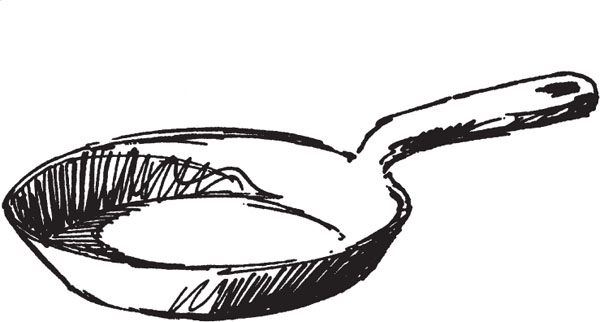
The skillet or frying pan is the most popular piece of modern cast-iron cookware.
One of my sons doesnt wash anything, with or without mechanical aid, and he can somehow mess up the nonstick surface of a cast-iron skillet while merely scrambling half a dozen chicken eggs for a light breakfast. Then he leaves the mess on a hot stove to harden. The boy shows a talent for cooking, and, for that reason, I try not to fuss at him. But maybe the time has come for him to get his own skillet. He will, Im sure, start off with Teflon. After wearing out several dozen of these, at considerable expense, he will come to his senses, and, remembering his fathers smother-fried round steak, he will discover the wisdom of the old ways. Cast-iron cooking is an American tradition, started no doubt at hearthside by the colonial goodwives and spread across the country by the brave, hardy women who followed the pioneers westward. But, alas, its a tradition that must be carried on by us menfolks. Recall the mountain man, the 49er, the cowboy, and, perhaps, the firemen of Nantucket.
After iron ore has been smelted in a blast furnace, the immediate product is called pig iron. It can be refined further into wrought iron or steel, or it can be cast into pots, vats, Dutch ovens, and so on, in which case it is called cast iron.
Unlike steel, cast iron has no great tensile strength, and it tends to be somewhat brittle. Nor can it be easily forged. But it is easy to sand cast, and it happens to withstand high temperatures. Thus, it is ideal for use in cookware that is used on red-hot coals in a fireplace or at a campsite.
Further, cast iron is a rather porous material, and it will take what is called a seasoning or sweetening. In short, it more or less absorbs oil, which, in cooking, forms a protective coating on the surface, so that a drop of water will dance on it. Cast iron is the original no-stick material, and it lasts until the sweetening is lost by mistreatment. Sweetening and caring for cast-iron cookware are discussed a few paragraphs below.
Moreover, cast-iron cookware heats evenly and holds heat for a long time, as compared with aluminum. Partly because of its thickness, cast-iron cookware isnt as likely to have hot spots, and it isnt as likely to burn food on the bottom.
One disadvantage is that cast-iron cookware is quite heavy, partly because thin pieces would be more difficult to sand cast. A 12-inch skillet, for example, weighs 7 pounds, and an 8-quart Dutch oven with lid weighs 16 pounds. Clearly, this stuff isnt for the backpacker, although it might be a purely excellent choice for a remote camp, simply because it is very versatile, quite durable, and will cook everything from sourdough bread to beaver stew.
Another disadvantage is that a cast-iron piece will sometimes crack if it is heated fast and unevenly. For this reason, large cast-iron vats and wash pots are usually partly filled with water or lard before they are heated. Cracking usually isnt a problem, however, with the smaller pieces. Most cast-iron cookware can be put directly onto a hot bed of campfire coals without a problem. It wont warp like lighter cookware. Further, cast iron is the only cookware that withstands, time after time, the heat required for cooking blackened redfish and similar dishes.
Because I stood my ground as a bachelor for a good many yearsthirty-nine to be exactsome people believe that I am stubborn and somewhat set in my ways. This is not the case. Its simply that, in some matters, there is a right way and a wrong. As for cast iron, there are no ifs, ands, or buts about it: Either a skillet sticks or it doesnt.


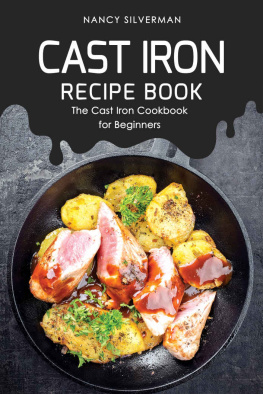
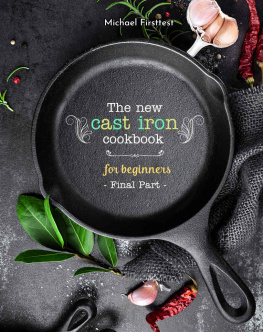
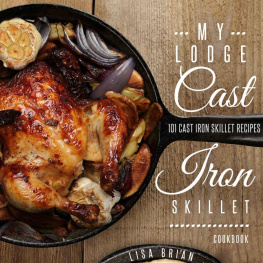

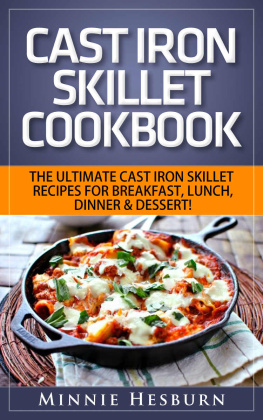




 The paper used in this publication meets the minimum requirements of American National Standard for Information SciencesPermanence of Paper for Printed Library Materials, ANSI/NISO Z39.48-1992.
The paper used in this publication meets the minimum requirements of American National Standard for Information SciencesPermanence of Paper for Printed Library Materials, ANSI/NISO Z39.48-1992.